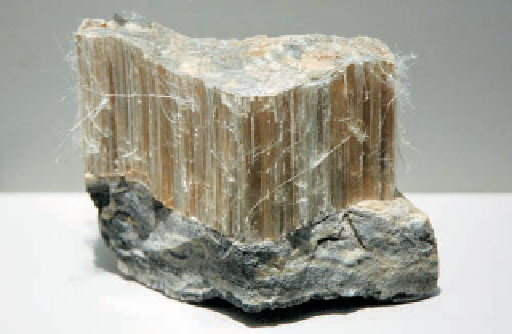Geology Reference
In-Depth Information
?
Aureoles range from a few centimeters wide bordering small
dikes and sills, to several hundred meters or even several
kilometers wide around large plutons.
The degree of metamorphic change within an aureole
generally decreases with distance from the intrusion,
refl ecting the decrease in temperature from the original heat
source. The region or zone closest to the intrusion, and hence
subject to the highest temperatures, commonly contains
high-temperature metamorphic minerals (that is, minerals
in equilibrium with the higher-temperature environment)
such as sillimanite. The outer zones, that is, those farthest
from the intrusion, are typically characterized by lower-
temperature metamorphic minerals such as chlorite, talc,
and epidote.
Contact metamorphism can result not only from igneous
intrusions, but also from lava fl ows, either along mid-ocean
ridges (Figure 7.4) or from lava fl owing over land and ther-
mally altering the underlying rocks (
What Would You Do
The problem of removing asbestos from public buildings is
an important national health and political issue. The current
policy of the U.S. Environmental Protection Agency (EPA)
mandates that all forms of asbestos are treated as identical
hazards. Yet studies indicate that only one form of asbestos
is a known health hazard. Because the cost of asbestos
removal has been estimated to be as high as $100 billion,
many people are questioning whether it is cost effective to
remove asbestos from all public buildings where it has been
installed.
As a leading researcher on the health hazards of asbes-
tos, you have been asked to testify before a congressional
committee on whether it is worthwhile to spend so much
money for asbestos removal. How would you address this
issue in terms of formulating a policy that balances the
risks and benefi ts of removing asbestos from public build-
ings? What role would geologists play in formulating this
policy?
◗
Figure 7.6). Whereas
recognizing a recent lava flow and the resulting contact
Geo-Focus
Asbestos: Good or Bad?
Asbestos
(from the Latin, meaning
“unquenchable”) is a general term
applied to any silicate mineral that eas-
ily separates into fl exible fi bers. The
combination of such features as fi re
resistance and fl exibility makes asbes-
tos an important industrial material of
considerable value. In fact, asbestos has
more than 3000 known uses, includ-
ing brake linings, fi reproof fabrics, and
heat insulators.
Asbestos is divided into two broad
groups:
serpentine asbestos
and
amphibole
asbestos
.
Chrysotile
is the fi brous form
of serpentine asbestos (
discontinuous
serpentine bands
within the car-
bonate beds.
Among the
varieties of am-
phibole asbestos,
crocidolite
is the
most common.
Also known as
blue asbestos,
crocidolite is a
long, coarse, spin-
ning fi ber that is
stronger but more
brittle than chrys-
otile and also less
resistant to heat.
Crocidolite is found in such metamor-
phic rocks as slates and schists and
is thought to form by the solid-state
alteration of other minerals as a result
of deep burial.
Despite the widespread use of asbes-
tos, the U.S. Environmental Protection
Agency (EPA) instituted a gradual ban
on all new asbestos products. The ban
was imposed because some forms of
asbestos can cause lung cancer and
◗
Figure 1
Specimen of chrysotile from Arizona. Chrysotile is the
fi brous form of serpentine asbestos and the most commonly used
in buildings and other structures.
◗
Figure 1); it is
the most valuable type and constitutes
the bulk of all commercial asbestos. Its
strong, silky fi bers are easily spun and
can withstand temperatures as high as
2750°C.
The vast majority of chrysotile
asbestos is in serpentine, a type of
rock formed by the alteration of
ultra-mafi c igneous rocks such as
peridotite under low- and interme-
diate-grade metamorphic condi-
tions. Other chrysotile results when
the metamorphism of magnesium
limestone or dolostone produces
scarring of the lungs if fi bers are
inhaled.
Because the EPA apparently paid
little attention to the issue of risks
versus benefi ts when it enacted this
rule, the U.S. Fifth Circuit Court of
Appeals overturned the EPA ban on
asbestos in 1991.
The threat of lung cancer has also
resulted in legislation mandating the
removal of asbestos already in place


Search WWH ::

Custom Search